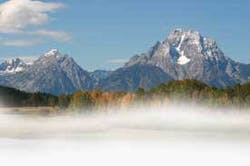Utility Finds Efficiency with Single Source Lift Station Technology
The town of Wilson, WY, is at the gateway to Teton Pass. In the winter, the region is used by thousands of visitors as a backcountry skiing and snowboarding playground. In the summer, it offers everything from downhill mountain biking to casual day hikes. Each year, the area grows in popularity, bringing new tourism and population growth alike.
In this rugged terrain of Wyoming, however, where temperatures can range from sub zero to 100 degrees, managing the city’s sewer system can be challenging. To be successful, the engineering team at the Wilson Sewer District (WSD) carefully studies current operations as well as changes on the horizon, including the potential uses of vacant land and the consideration of how that land will be developed for short-term and the long-term planning. WSD is responsible for overseeing the sewer and water needs of the local residents, and it is this team of engineers who are responsible for keeping things flowing in the right direction.
Packaged Deal
With the assistance of Nelson Engineering and Water Works Industries Inc., the area waste management distributor that serves and consults with the WSD regarding strategic design, WSD erected five lift stations spanning 13 miles of pipeline to service the area. Gorman-Rupp lift stations were selected for the project, based on the company’s reputation and its ability to set six-, eight- and 10-foot-diameter wet wells with completely integrated, packaged lift stations. In addition to these stations, two more lift stations were also installed in the heart of Wyoming’s ski district, Teton Village.
The stations are equipped with Gorman-Rupp Super JSV-Series pumps. All the stations are pumping into the same force main. From there, waste is pumped to a larger lift station, which moves the waste across the Snake River, encompassing yet another 13,000 feet of force main.
When deciding upon a strategy for effective waste management, WSD weighed the durability of the proposed equipment. Selecting pumps that could withstand constant use and harsh weather conditions was of the uppermost importance. From the start, the climate and elevation had a significant influence on equipment decisions.
In the planning stages of the operation, the team knew they weren’t dealing with a standard platform and a typical waste management challenge.
“From the start, it was also very important to us to minimize the number of lift stations - from an operational standpoint,” Wagner said.
The WSD team also expected to face a challenge with high groundwater during the installation phase, so they wanted a system that would be easy to install. In the end, installation took about half a day per station.
“We pulled them off the truck, set them, and we were done,” Wagner said.
Duplex Stations
Even though a single submersible, centrifugal pump could do the job, WSD employs a duplex pump system to prevent unnecessary emergencies, and to assist in effective planning for the continued flow of the system. Per the plan, each pump is strategically alternated. In doing so, the authority has the ability to pull a pump that goes down without disrupting the overall service of the area while the necessary repairs are being made.
The district can also run a “lead and lag” option with the pump stations to handle varied wastewater flow. When the volume of water reaches an unmanageable level, the pump station automatically shifts to an alarm mode, notifying the operator that the standby pump is operating. The operator can easily adjust the on/off-alarm settings.
WSD particularly likes the idea of “a single source of responsibility” for all the parts of the station. Gorman-Rupp lift stations encompass a total, single source pumping solution, including not only pumps, but electronics, controls and pressure switches.
“All of the controls, all of the valves, all of the pumps are from one supplier - and we don’t ever have any finger pointing. That makes it very easy,” Wagner said.
Spare Parts
Gorman-Rupp maintains a large spare parts inventory, available through its headquarters within 48 hours. Many repair components are interchangeable between lift stations.
“The key here is that we can replace a worn component very quickly with readily available parts. Its is absolutely critical that these things run 24 hours a day, seven days a week,” Wagner said.
Pumps used in the stations have a removable cover plate, allowing for access to the pump’s interior without disconnecting piping. The impeller, seal, wearplate and flap valve can all be accessed through the cover plate opening for routine inspection or service.
All the stations’ components, including valves and electrical, are above ground.
“The pumps in the individual lift stations may be different sizes, but all of the controls and other components remain interchangeable,” Norton said.


